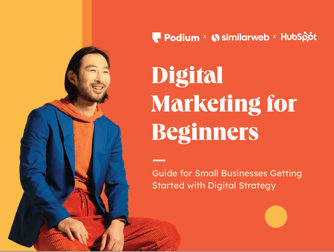-

Why Everyone Is a Social Media Entrepreneur Right Now — Trends You Need to Know
I chatted with some of the best in social media entrepreneurship to learn the whys and how...
Brianne Garrett
3/26/25
-

10 Excellent Examples of Video Marketing on Facebook
Ready to dive into Facebook video marketing? Check out this list of top Facebook video exa...
Ryan Philemon
3/26/25
-

How to Create a Great Social Media Strategy in 2025 [+ New Data]
Learn how to develop a social media strategy that drives traffic and delivers real ROI to ...
Allie Decker
3/25/25
-

15 Best Social Media Organization Tips and Tricks for Managers
Learn the best social media organization tips from industry experts to help you organize s...
Ramona Sukhraj
3/25/25
From HubSpot's video library
-
.jpg?height=240&name=YT-237_A%20(1).jpg)
How to Start Affiliate Marketing With No Experience or Money (4 Free Tools!)
-

How Airlines Really Make Money | Hustlenomics | The Hustle
-
.jpg?height=240&name=IMG_0735%20(1).jpg)
What Entrepreneurs Can Learn From Native Deodorant
-

Meet the Designer Behind the Iconic Nudie Suit | Unknown Empires
-

Tips For Elevating Your Next Go-To-Market Strategy (+ Free Templates)
-

Why T-Mobile Trademarked This Color | The Hustle
-
.jpg?height=240&name=YT-237_A%20(1).jpg)
How to Start Affiliate Marketing With No Experience or Money (4 Free Tools!)
-

How Airlines Really Make Money | Hustlenomics | The Hustle
-
.jpg?height=240&name=IMG_0735%20(1).jpg)
What Entrepreneurs Can Learn From Native Deodorant
-

Meet the Designer Behind the Iconic Nudie Suit | Unknown Empires
-

Tips For Elevating Your Next Go-To-Market Strategy (+ Free Templates)
-

Why T-Mobile Trademarked This Color | The Hustle
-
.jpg?height=240&name=YT-237_A%20(1).jpg)
How to Start Affiliate Marketing With No Experience or Money (4 Free Tools!)
-

How Airlines Really Make Money | Hustlenomics | The Hustle
-
.jpg?height=240&name=IMG_0735%20(1).jpg)
What Entrepreneurs Can Learn From Native Deodorant
-

Meet the Designer Behind the Iconic Nudie Suit | Unknown Empires
-

Tips For Elevating Your Next Go-To-Market Strategy (+ Free Templates)
-

Why T-Mobile Trademarked This Color | The Hustle
-

I Took a Deep Dive Into Market Segmentation — Here's Everything I Learned
I took a deep dive into market segmentation. Here’s everything I learned.
Diego Alamir
3/18/25
-

Testimonial Questions Reps Need to Ask Their Customers
Not all testimonials are created equal — use these 25 smart questions to capture customer ...
Ashley Valadez
3/17/25
-

How the Customer Journey Funnel Revamps Traditional Methods and Drives Business
See how the customer journey funnel helps businesses nurture leads, boost retention, and t...
Ashley Valadez
3/14/25
-

AI Intent — Figuring Out the Purpose that Drives Service Tech
AI intent is an AI system’s ability to understand the meaning behind a user’s input. Disco...
Kolawole Samuel Adebayo
2/21/25

An Introduction to Digital Marketing
Learn the basics of digital marketing and explore different ways to reach your ideal customer.
-

How to Find a Meeting Time That Works for Everyone [+ Tools]
In this comprehensive guide, I'll share the exact strategies and tools I use to find a mee...
Saphia Lanier
3/26/25
-

10+ Ways to Enhance a Sales Presentation, According to Experts
When it comes to nailing a sales presentation, remember to follow this basic rule: Care ab...
Brianne Garrett
3/26/25
-

5 Best Sales Enablement Platforms of 2025
Want to make your sales process easier? Discover the best sales enablement platforms to he...
Taylor Cromwell
3/26/25
-

Want to Create a Sales Plan? Let Me Show You How [+ 10 Sales Plan Examples]
Sales planning is an essential component of strong selling. This guide to the sales planni...
Jay Fuchs
3/25/25
From the HubSpot Podcast Network
-
Business Made Simple

Your Website Probably Stinks—Here’s How to Fix It!
-
The Science of Scaling

How to Scale a Billion Dollar Sales Team w/ John McMahon (Board Member, Snowflake)
-
Truth, Lies and Workplace Culture
-2.png?height=240&name=PodcastCovers23%20(1)-2.png)
From Bystander to Ally: How to Avoid DEIB Washing
-
Imperfect Action
-2.png?height=240&name=PodcastCovers23%20(4)-2.png)
The art of the post-launch review: 5 questions to make your next launch a success
-
Latinx In Power
.png?height=240&name=PodcastCovers23%20(6).png)
Harnessing the Power of Silence in Negotiation with Diana Kleps
-
The Sales Evangelist

5 Ways To Do Daily Outbound With LinkedIn
-
Business Made Simple

Your Website Probably Stinks—Here’s How to Fix It!
-
The Science of Scaling

How to Scale a Billion Dollar Sales Team w/ John McMahon (Board Member, Snowflake)
-
Truth, Lies and Workplace Culture
-2.png?height=240&name=PodcastCovers23%20(1)-2.png)
From Bystander to Ally: How to Avoid DEIB Washing
-
Imperfect Action
-2.png?height=240&name=PodcastCovers23%20(4)-2.png)
The art of the post-launch review: 5 questions to make your next launch a success
-
Latinx In Power
.png?height=240&name=PodcastCovers23%20(6).png)
Harnessing the Power of Silence in Negotiation with Diana Kleps
-
The Sales Evangelist

5 Ways To Do Daily Outbound With LinkedIn
-
Business Made Simple

Your Website Probably Stinks—Here’s How to Fix It!
-
The Science of Scaling

How to Scale a Billion Dollar Sales Team w/ John McMahon (Board Member, Snowflake)
-
Truth, Lies and Workplace Culture
-2.png?height=240&name=PodcastCovers23%20(1)-2.png)
From Bystander to Ally: How to Avoid DEIB Washing
-
Imperfect Action
-2.png?height=240&name=PodcastCovers23%20(4)-2.png)
The art of the post-launch review: 5 questions to make your next launch a success
-
Latinx In Power
.png?height=240&name=PodcastCovers23%20(6).png)
Harnessing the Power of Silence in Negotiation with Diana Kleps
-
The Sales Evangelist

5 Ways To Do Daily Outbound With LinkedIn
-

45 Website Pop-up Examples That Get Clicks
Explore some of the best website pop-up designs that get clicks, generate leads, and keep ...
Jamie Juviler
3/26/25
-

Primary and Secondary Navigation Explained, Making the Right Decision for Your S...
Learn the difference between primary and secondary navigation, two essential components fo...
Jamie Juviler
3/26/25
-

Yes, You Need a UX Persona. Here's Why & How to Create One
Learn how to create UX personas for your design projects. Understand the importance of use...
Althea Storm
3/25/25
-

25+ Web3 Website Examples to Inspire Yours
Discover the best Web3 websites that combine decentralization with stunning user experienc...
Nathan Ojaokomo
3/24/25
-
Gradient Website Design Examples That Prove This Trend Is Far From Over [+Tutori...
Discover the power of gradient website design. Learn how to use gradients effectively, and...
Althea Storm
3/24/25
-

Website Navigation: How to Design Menus Visitors Love [Examples]
Learn how to design your website navigation according to best practices and examples from ...
Anna Fitzgerald
3/24/25
Explore more topics
Ready to brush up on something new? We've got more to read right this way.






.png)
